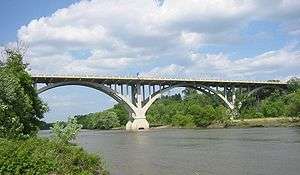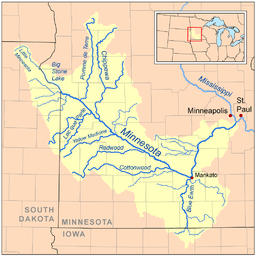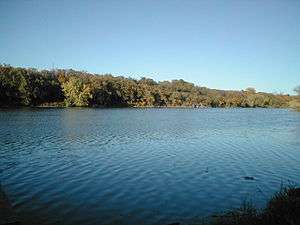Minnesota River
| Minnesota River (Watpá Mnísota) | |
| River | |
 The Mendota Bridge crossing the Minnesota River, just above its mouth | |
| Country | United States |
|---|---|
| State | Minnesota |
| Cities | Bloomington, MN, Eden Prairie, MN, Mankato, MN, Shakopee, MN, Burnsville, MN, Eagan, MN, Le Sueur, MN |
| Source | Big Stone Lake |
| - location | Big Stone Lake, Big Stone County, MN |
| - elevation | 964 ft (294 m) |
| Mouth | Mississippi River |
| - location | Near Fort Snelling in Minnesota, Hennepin County, MN |
| - elevation | 690 ft (210 m) |
| Length | 370 mi (595 km) |
| Basin | 17,000 sq mi (44,030 km2) |
| Discharge | |
| - average | 4,414 cu ft/s (125 m3/s) |
 Map of the Minnesota River | |
The Minnesota River is a tributary of the Mississippi River, approximately 332 miles (534 km) long, in the U.S. state of Minnesota. It drains a watershed of nearly 17,000 square miles (44,000 km2), 14,751 square miles (38,200 km2) in Minnesota and about 2,000 sq mi (5,200 km2) in South Dakota and Iowa.
It rises in southwestern Minnesota, in Big Stone Lake on the Minnesota–South Dakota border just south of the Laurentian Divide at the Traverse Gap portage. It flows southeast to Mankato, then turns northeast. It joins the Mississippi south of the Twin Cities of Minneapolis and St. Paul, near the historic Fort Snelling. The valley is one of several distinct regions of Minnesota. Of Dakota language origin, the name Minnesota means "sky-tinted water or cloudy-sky water", from mní (often transcribed as "minne" or "mini") meaning "water" and sóta meaning "sky-tinted" or "cloudy sky", and, refers to the milky-brown color its waters take on when at flood stage. An illustration of the meaning of these words was shown by dropping a little milk into water. For over a century prior to the organization of the Minnesota Territory in 1849, the name St. Pierre (St. Peter) had been generally applied to the river by French and English explorers and writers. Minnesota River is shown on the 1757 edition of Mitchell Map as "Ouadebameniſsouté [Watpá Mnísota] or R. St. Peter". On June 19, 1852, acting upon a request from the Minnesota territorial legislature, the United States Congress decreed the aboriginal name for the river, Minnesota, to be the river’s official name and ordered all agencies of the federal government to use that name when referencing it.[1][2]
The valley that the Minnesota River flows in is up to five miles (8 km) wide and 250 feet (80 m) deep.[3] It was carved into the landscape by the massive glacial River Warren between 11,700 and 9,400 years ago at the end of the last ice age in North America. Pierre-Charles Le Sueur was the first European to visit the river. The Minnesota Territory, and later the state, were named for the river.
Commercial significance
The river valley is notable as the origin and center of the canning industry in Minnesota. In 1903 Carson Nesbit Cosgrove, an entrepreneur in Le Sueur presided at the organizational meeting of the Minnesota Valley Canning Company (later renamed Green Giant).[4][5] By 1930, the Minnesota River valley had emerged as one of the country's largest producers of sweet corn. Green Giant had five canneries in Minnesota in addition to the original facility in Le Sueur. Cosgrove's son, Edward, and grandson, Robert also served as heads of the company over the ensuing decades before the company was acquired by General Mills.[6] Several docks for barges exist along the river. Farm grains, including corn, are transported to the ports of Minneapolis and Saint Paul, and then shipped down the Mississippi River.
Tributaries
| Order of entry | River | Location of confluence |
|---|---|---|
| 11 | Blue Earth River | West side of Mankato |
| 6 | Chippewa River | Montevideo |
| 9 | Cottonwood River | Southeast of New Ulm |
| 13 | Credit River | Scott County, just southeast of Minneapolis–Saint Paul |
| 5 | Lac qui Parle River | Lac qui Parle State Park, 10 mi (15 km) northwest of Montevideo |
| 10 | Little Cottonwood River | Cambria Township, 7 mi (11 km) southeast of New Ulm |
| 1 | Little Minnesota River | Big Stone Lake in Browns Valley |
| 4 | Pomme de Terre River | Marsh Lake in southwestern Swift County, 4 mi (6 km) southwest of Appleton |
| 8 | Redwood River | Near Redwood Falls |
| 12 | Rush River | 2.9 mi north of Le Sueur |
| 2 | Whetstone River | Ortonville, near the South Dakota state line |
| 3 | Yellow Bank River | Agassiz Township, 3 mi (5 km) southeast of Odessa |
| 7 | Yellow Medicine River | Upper Sioux Agency State Park in Sioux Agency Township |
Cities and towns

See also
Notes and references
- ↑ ""Minnesota State".". Minnesota Historical Society. Archived from the original on 31 March 2015. Retrieved 2010-03-21.
- ↑ Mary Wheelhouse Berthel (June 1948). Horns of Thunder: The Life and Times of James M. Goodhue. Minnesota Historical Society. pp. 179–. ISBN 978-0-87351-518-4.
- ↑ Sansome, Minnesota Underfoot, pp. 118-19.
- ↑ "Peas, corn and beyond: Minnesota's Green Giant company was a canned food pioneer". MinnPost. 1 August 2013. Retrieved 6 October 2015.
- ↑ Minnesota: A State Guide. US History Publishers. 1938. pp. 388–. ISBN 978-1-60354-022-3.
- ↑ "The Cosgrove Years". Mayohouse.org. Retrieved 2007-12-12.
Sources
- Sansome, Constance Jefferson (1983). "Minnesota Underfoot: A Field Guide to the State's Outstanding Geologic Features". Stillwater, MN: Voyageur Press. ISBN 0-89658-036-9.
- Waters, Thomas F. (1977). The Streams and Rivers of Minnesota. Minneapolis: University of Minnesota Press. ISBN 0-8166-0960-8.
- Place Names: the Minnesota River
External links
| Wikimedia Commons has media related to Minnesota River. |
- Drainage Area of the Minnesota River
- History of the Minnesota River Valley
- Minnesota River at Mankato - pictures and more information
- Minnesota River Basin Data Center - center at Minnesota State University, Mankato
 "Minnesota River". Collier's New Encyclopedia. 1921.
"Minnesota River". Collier's New Encyclopedia. 1921. "Minnesota, a river which crosses the state of Minnesota". The New Student's Reference Work. 1914.
"Minnesota, a river which crosses the state of Minnesota". The New Student's Reference Work. 1914. "Minnesota, or St. Peter's, a river of Minnesota". The American Cyclopædia. 1879.
"Minnesota, or St. Peter's, a river of Minnesota". The American Cyclopædia. 1879.
Coordinates: 45°18′10″N 96°27′07″W / 45.30278°N 96.45194°W